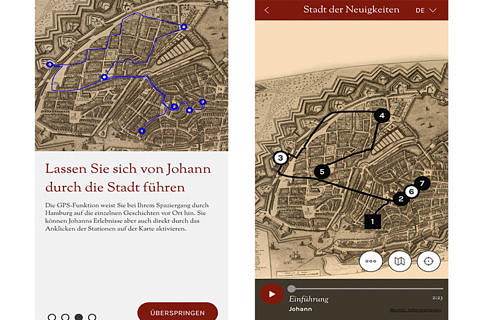Exploring Hamburg in 1686 through an interactive tour
International research project brings five European cities to life from the Early Modern period to the present
How were public spaces used in European cities between 1450 and 1700? What happened in the narrow streets and major city squares, which buildings were important and why? How did normal people influence and experience life in the city? And what does this all have to do with us today? ‘PUblic REnaissance: Urban Cultures of Public Space between Early Modern Europe and the Present’ (PURE) is an international research project which has received one million euros in funding to find answers to these questions. Friedrich-Alexander-Universität Erlangen-Nürnberg (FAU) is the German partner university in the project. Researchers at FAU have developed an app and a website drawing on their research into the Early Modern period to create an interactive tour of Hamburg in the year 1686.
‘Moin, moin, my name is Johann and I am a paper merchant from Hamburg,’ welcomes the virtual guide in the app, as he prepares to take his visitors on an interactive tour of the City of Hamburg in 1686. The creative minds behind Johann and his tour through the city are Prof. Dr. Daniel Bellingradt, Assistant Professor for Book Studies with a focus on historical communication research and research associate Claudia Heise. The FAU team developed an interactive tour of Hamburg in the year 1686 which lasts for approximately one hour and is available free of charge in German and English. Johann leads his guests through familiar and unknown sites in Hamburg on a journey full of intriguing discoveries. As Johann tells us, many things happened in Hamburg during 1686.
Turbulent times in the city of Hamburg during 1686
‘We selected seven locations in Hamburg today, which the tour guests can visit themselves,’ explains Bellingradt. ‘And when the GPS signal is in the correct place, visitors can experience part of the history based on the fictitious character of Johann the paper merchant.’ However, it is also possible to visit each of the stations virtually without GPS tracking and walking through Hamburg. The text, graphics and audio are all described in an easy to follow way, telling hidden stories of the city and offering insights into museum objects and archived materials. To bring the history of Hamburg to life, the FAU team partnered with the Museum for Hamburg History.
‘The interactive tour is a walk through Hamburg where the geographical coordinates from a historical map from 1686 have been linked interactively to a current map of the city. Visitors witness turbulent times in Hamburg at a time when two Hamburg politicians have recently been publicly executed, pamphlets have been burned and all sorts of gossip is spreading throughout the coffee houses and public houses,’ says Heise. ‘Our guide Johann is on the lookout for pamphlets and the latest rumours, guiding the app users to bookshops, churches, newspaper stands in marketplaces, a coffee house and the opera.’
‘Each of the selected locations in Hamburg draws attention to social spaces that bring people together to communicate. Places where goods, knowledge and news are produced, sold and consumed and where people contested the interpretation of sovereignty,’ explains communication historian Prof. Dr. Daniel Bellingradt. ‘Throughout our tour of the city, we discover traces of the Early Modern period and learn that the past and present city had much in common, not least in the streets and squares that remain for the most part today.’ Through partnerships with museums, archives and cultural organisations, visitors can also experience historical objects, ranging from valuable satirical medals to cheap prints that are connected with social spaces in the city and that are currently in exhibitions or storage.’
Increasing the visibility of the humanities.
PURE is an international humanities research project which will receive one million euros in funding from 2019 to 2022. The German project is being funding by Humanities in the European Research Area (HERA) and the Federal Ministry of Education and Research (BMBF). The HERA network is a collaboration between 26 European research funding institutions and the EU Commission with the aim of increasing the visibility of the humanities in the European research area and EU research framework programmes.
Interactive website and app
The other partner universities in the international research project, Rijksuniversiteit Groningen in the Netherlands, the University of Exeter in the UK, the Universitat de València in Spain and the Italian-German Historical Institute in Trento, Italy have also created similar case studies of the four European cities Exeter, Deventer, Valencia and Trento. Visitors to the interactive website are now able to navigate their way through the five cities, examine objects, discover activities and compare places in an entertaining and educating way, as well as explore these cities in the present. The apps are available to download free of charge at the Google Play Store (Android) and the Apple App Store.
Further information
Homepage of Hidden Cities and Hidden Hamburg
Prof. Dr. Daniel Bellingradt
Assistant Professor for Book Studies, with a focus on historical communication research
daniel.bellingradt@fau.de
